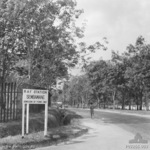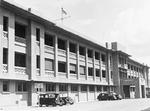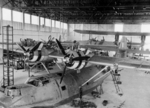
Singapore
| Full Name | 133 Straits Settlements | |
| Alliance | Allies - Minor Member Nation or Possession | |
| Possessing Power | United Kingdom | |
| Entry into WW2 | 8 Dec 1941 | |
| Population in 1939 | 1,370,300 | |
| Civilian Deaths in WW2 | 40,000 |
Contributor: C. Peter Chen
ww2dbaseIn 1867, the Straits Settlements was created a Crown Colony, consisting of four states: Penang, Dinding, and Malacca on the western coast of the Malay Peninsula, and Singapore on the southern tip of the peninsula. Singapore served as the capital. Christmas Island, Cocos Islands, and Labuan island would later fall under the Straits Settlements administration. Population of the Straits Settlements surpassed 1,000,000 in the mid-1930s; in addition to Malays and the European minority, there were also many ethnic Indians and ethnic Chinese among the population. In Feb 1935, Dinding was returned to the state of Perak of the Federated Malay States, a British protectorate, due to the goal of developing it as a harbor having failed.
ww2dbaseThe Malay Peninsula was among the first targets of the Japanese during the Pacific War. On 15 Dec 1941, Penang became the first of the Straits Settlements to become captured, followed by Malacca on 15 Jan 1942. After two weeks of fighting, at 1400 hours on Sunday, 15 Feb, Arthur Percival decided that he only had enough supplies for two more days of fighting, and surrendered. It had been said that much of defense efforts were spent on coastal defenses in the south of Singapore, in the thinking that a ground invasion would either be unlikely or there would be ample time given that the entire Malaya Peninsula would form a buffer zone. If this was true, then Japan proved it to be a faulty plan. Prime Minister Winston Churchill called the loss of Singapore "the worst disaster and largest capitulation in British history".
ww2dbaseJapanese atrocities began in Singapore even before the surrender. Lieutenant Western, a British medical officer, surrendered with a white flag but was bayoneted to death. Then, the Japanese troops entered the Alexandra Hospital, killing over 300 doctors, nurses, and patients, most by bayonet. Atrocities were not limited to Singapore. Civilians were massacred en masse throughout the entire Malaya Peninsula. In Tanjong Kling, Malacca, for example, 142 ethnic Chinese civilians were massacred on 16 Mar 1942. Ethnic Chinese suffered a harsher occupation than the others in the Strait Settlements, for that the Chinese community as a whole were known to have contributed financially to the war efforts in China. Daikensho ("The Great Inspection"), also known as Sook Ching ("The Purge") after the war, was a Japanese ethnic cleansing operation aimed at eliminating any kind of leadership among the Chinese communities. It was estimated that 25,000 to 50,000 were killed during the operation across the entire Malay Peninsula.
ww2dbaseDuring the occupation, Japan ruled the Malaya Peninsula with a military government. Efforts were made to impress Japanese culture and custom. To that end, the time zone was changed to align with Japan, the Japanese language was made the official language, and Japanese social customs such as bowing became required when local civilians encountered Japanese nationals. To control information, all newspapers were combined into a new company, Penang Shinbun, which was run as a subsidiary of the Japanese news agency Domei Tsushin. Furthermore, many place names were given new Japanese names; for example, Singapore was renamed Syonan To ("Island of Southern Light") and Penang was renamed Tojo To ("(Prime Minister) Hideki Tojo's Island"). As more and more daily necessities were taken by the Japanese to fuel the war efforts, prices soared, making life difficult; the occupation government soon introduced a ration system to ease the situation, but the allotted food for each person was not considered adequate, and the Japanese encouraged gardens at home to grow extra food. This was one of the reasons that a black market thrived.
ww2dbaseJapanese-occupied Singapore was also the home of the Japanese-sponsored Indian National Army, an organization that later evolved into the Government of Free India, also based in occupied Singapore.
ww2dbaseThe port of Penang served not only the Japanese Navy but also their German and Italian counterparts, making it one of the rare occasions where all three Axis fully cooperated militarily; 5 German submarines were stationed in Penang during the war.
ww2dbaseAfter the war, Penang and Malacca joined the newly formed Malayan Union, while Singapore remained an independent entity. Labuan was transferred to British North Borneo in Jul 1946. The Malaya Union was renamed the Federation of Malaya in 1948. The Cocos Islands were transferred to Australia in 1955. Christmas Island was transferred to Australia in 1958. On 31 Aug 1957, the Federation of Malaya gained independence. On 16 Sep 1963, the nation of Malaysia was formed, which included the Malay Peninsula, Singapore, Sarawak, and North Borneo. Singapore would later be expelled from Malaysia due to racial and political tensions, forming an independent city state.
ww2dbaseSources:
William Manchester, American Caesar
Wikipedia
Last Major Update: Jan 2018
| People | ||
| Lim, Bo Seng | ||
| Events Taken Place in Singapore | ||
| Invasion of Malaya and Singapore | 8 Dec 1941 - 15 Feb 1942 | |
| Japan's Surrender | 14 Aug 1945 - 2 Sep 1945 | |
| Facilities | ||
| Changi Prison and Selarang Barracks | Prison Camp | |
| Sembawang Bases | Air Base, Army Base, Navy Base, Shipyard | |
Photographs
 |  |  |  |